Movie Retrospective: Rope
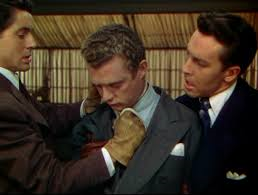
Alfred Hitchcock’s first creative decade spent in Hollywood (namely the 1940s) produced a mix of both the sublime (Rebecca, Foreign Correspondent, Shadow of a Doubt, Lifeboat, Notorious) and some lesser works by the master of suspense (such as Mr. and Mrs. Smith, The Paradine Case and Under Capricorn), but there is little doubt that the director’s most experimental piece during these years came by way of 1948’s Rope. Based on the 1929 play of the same name by Patrick Hamilton (with a treatment by actor Hume Cronyn and script by Arthur Laurents), Rope tells the story of two friends who kill a former classmate in order to realise the ‘perfect murder.’ Following an utterly tranquil street scene (shown during the opening credits), the film begins with the foul deed itself. From behind the curtained window of an apartment, the scream of a man is audible and inside we see the grisly crime just after it has taken place. The apartment in question – the sole setting for the film as the drama unfolds – is attractive, well-furnished and has a most glorious view of the Manhattan skyline. ‘A lovely evening,’ Brandon (John Dall) observes after he has helped Phillip (Farley Granger) hide the lifeless body inside an antique wooden chest, ‘pity we couldn’t have done it with the curtains open and in the bright sunlight.’ Brandon’s demeanour is a curious mix of restraint and exhilaration as he lights a cigarette. Phillip’s, on the other hand, is one of confusion and anxiety. The authoritative Brandon tries to contextualise what they have just done – ‘It was perfect, an immaculate murder’; he also strives to make light of it for Phillip’s benefit – ‘Course he was a Harvard graduate, that might make it justifiable homicide.’ The victim we soon learn is one David Kentley and the two men are throwing a party that same evening which will be attended by David’s parents. ‘It’s the inspired finishing touch,’ the self-satisfied Brandon declares. In a further act of audacity, he decides to set up the dinner arrangements on the very chest which now contains David’s body. The intention is that the unwitting guests will be dining from his resting place. The first-time viewer can be forgiven for understandably wondering where this is all going. As the murder has already been committed, what is the source of suspense here? On a purely dramatic level, how exactly will this play out?
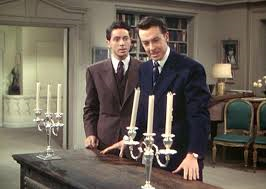
Rope’s detractors have criticised the film for being rather one note in this respect; they have also referred to it as constituting little more than a sustained elaborate trick with respect to the technique employed here by Hitchcock. The first of the director’s Technicolor productions, Rope is most distinctive with regard to its real-time setting and the manner in which it is filmed to suggest a single continuous shot. This is not the case as we know. The takes are much longer than the average film, lasting approximately ten minutes (the length of a film camera magazine), but watch carefully enough and you can spot those visual breaks. In order to cut to the next segment of film, Hitchcock simply has his camera pan against or track into an object in the room – the back of a man’s jacket suffices in several such places; the lid of the aforementioned chest masks the very last one which takes place during the climactic scene. The set of the film meantime (Brandon and Phillip’s plush apartment) was an adaptable environment with respect to its moveable walls and transportable furniture. In the 2001 documentary Rope Unleashed, actor Farley Granger recalls how the actors had to adhere to a carefully choreographed set of cues. The slightest verbal mistake or failure to hit a mark meant having to start from the beginning of a scene once again. Granger – who would collaborate with Hitchcock on his 1951 classic Strangers on a Train – speaks of his reverence for the director, but there is an implied pressure here as well which must have existed on the set. In a separate interview, screenwriter Laurents suggests how leading man James Stewart was not entirely certain of his place in the overall narrative. This was Stewart’s first film with Hitchcock (they worked together four times in total) and Laurents’s point is well made. On first sight Dall and Granger appear to be the central pairing, but then we are introduced to Stewart’s Rupert Cadell, their former prep school housemaster. Amiable as he is, the deference shown to him by Brandon in particular is unmistakable. And then there is the surmising on that character’s part as to how the older man would most likely appreciate what they have just done, heinous though it may be. Brandon even goes so far as to state that he had considered inviting Rupert to take part in this ‘perfect murder’ of theirs. This raises a question in the viewer’s mind as to what sort of individual this Cadell might be. Is he equally as callous? Is he a villain with some degree of charm in the vein of Brandon himself?
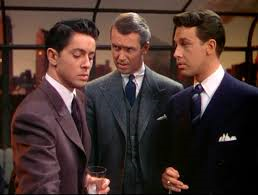
Rope is certainly not Hitchcock’s most visually dynamic film; its limited setting means that there is no scope for a climactic finish of the order of a North by Northwest or a Vertigo. Indeed, it becomes a tad pedestrian at times with respect to necessary real-time exposition which takes place as Mrs. Wilson (Edith Evanson) the housekeeper arrives and frets over the changed layout for the dinner party. The guests arrive then and they consist of Janet Walker (Joan Chandler), David’s apparent fiancee; Henry Kentley (Sir Cedric Hardwicke), David’s father; Anita Atwater (Constance Collier), David’s maternal aunt; and Kenneth Lawrence (Douglas Dick), another prep school friend who is also known to Rupert. The latter’s impending arrival is much heralded as Janet is regaled with stories of how Brandon literally venerated his former headmaster and, particularly, how Rupert expounded the theory that there are superior beings who are the privileged few. ‘Rupert’s extremely radical,’ Brandon observes in such a frame of mind and his words carry a sentiment – even a belief – that Stewart’s character would understand the Ubermensch impulse which has informed the act (and art) of this murder.
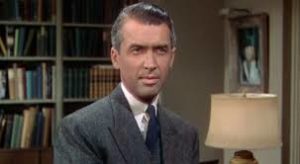
One of Rope’s most memorable lines of dialogue occurs just prior to Stewart’s entrance and it involves Farley Granger and the excellently pompous Constance Collier. Promoting herself as a fortune-teller of sorts, Aunt Anita examines the up-and-coming pianist’s hands telling him that, ‘these hands will bring you great fame.’ For Phillip and the viewer these words of course have a double-edged meaning; on the one hand they could signal a successful career at his chosen profession, on the other hand they may connote a particular infamy if he and Brandon are discovered. Despite the aforementioned remarks of Laurents in the documentary on the film, Rope works best for me when Stewart is present. He is sophisticated, erudite and playful at heart, teasing the admiring Mrs. Wilson and chatting freely with the other guests. Although it’s not named here, there’s a clear reference to Hitchcock’s 1946 film Notorious – Aunt Anita can’t remember what it’s called and simply refers to its title as ‘something.’ A more significant moment comes to pass, however, as Philip’s polite refusal of chicken from the buffet table raises some eyebrows and remarks. Overly-cocky in disposition at this point, Brandon reveals how his friend is quite adept at strangling chickens; he’s done so on his mother’s farm he insists. An increasingly jumpy Phillip, who has been drinking steadily, does not react well to this – ‘I never strangled a chicken in my life!’ he loudly protests. It’s the first moment of genuine tension which takes place in Rope apart from the earlier (and less significant) scene in which Janet scolds a smirking Brandon for inviting Kenneth to the party (the two had previously dated). A medium close-up of Stewart leaves us in little doubt as to his impression of the exchange. He can’t possibly guess at the reality of the situation just yet, but Mrs. Wilson has already planted in his mind the idea that something is slightly askew. In a demonstration of his intuitive ability, Rupert also comments on Brandon’s stammering which he says the young man has had a tendency to do when he gets ‘excited.’ The script and narrative thrust of the film quickly positions Rupert as the one most likely to uncover the murder. But, again, the question persists – What will he do if he finds out? Will he regard it as a consummate work of art (as Brandon would hope) or a reprehensible crime (as society at large would deem it)?
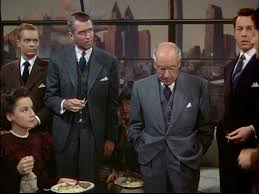
Much to Brandon’s personal delight, the conversation switches to a discussion on the nature and morality of murder which Rupert describes as, ‘an art,’ the privilege of which, ‘should be reserved for those few who are really superior individuals.’ Brandon readily agrees with this and irks Mr. Kentley who, in turn, compares this attitude to that of the Nazis and their atrocities in the recent war (‘Who is to decide that a human being is inferior and, therefore, a suitable victim?’). Hitchcock and Laurents thankfully do not allow this scene to become too long-winded and Stewart is given the opportunity to deliver some of the more amusing lines in Rope (infused as they are with Hitchcock’s familiar brand of black humour). Proffering the virtues of homicide generally, Rupert invites a suitably tickled Aunt Anita to consider the, ‘problems it would solve – unemployment, poverty, standing in line for theatre tickets…mind you, I don’t hold with the extremists who feel there should be open season for murder all year round. No, personally, I would prefer to have cut-a-throat week, or strangulation day.’ Such drollness is short-lived though as David’s absence is keenly felt and his worried mother (who has not attended the party on account of a cold) continues to phone inquiring after him. Conscious of Phillip’s tetchiness all evening, Rupert takes the opportunity to question him when the others leave the room to inspect a set of first-editions Brandon is presenting to Mr. Kentley. ‘You’re unusually allergic to the truth this evening,’ he comments with reference to Phillip’s earlier denial that he ever strangled chickens – ‘You’re quite a good chicken strangler as I recall.’ The jig appears to be up for both Phillip and Brandon when a departing Rupert is handed the wrong hat by Mrs. Wilson; the monogram inside it bears the initials DK as in David Kentley. In 1958’s Vertigo, Stewart’s ‘Scottie’ Ferguson guesses at the truth in somewhat similar circumstances as he recognises the necklace Kim Novak is wearing. ‘You shouldn’t keep souvenirs of a killing,’ he tells her in that climactic scene in the bell tower at Mission San Juan Bautista. ‘You shouldn’t have been that sentimental.’ Sentiment does not enter the equation here; this is just downright carelessness on the part of Brandon and Phillip. But the consequence of their mistake is more-or-less the same as Novak’s in Vertigo – the lead character now knows their dirty little secret. The only question that remains is how will he act. Having risen to and even surpassed Brandon’s expectations of him during the earlier conversation on the ‘art of murder,’ what will Rupert do with the power and responsibility of such knowledge?
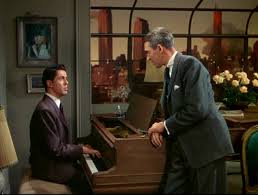
He returns to the apartment just a few minutes later on the false pretext that he has left his cigarette case behind him. Taking this as evidence that Rupert must surely suspect, Phillip becomes near-hysterical; Brandon, for his part, conceals a gun in his jacket pocket – ‘I’m not going to get caught because of you or anyone else,’ he tells a practically inebriated Phillip, ‘nobody is going to get in my way now.’ A wary Rupert quickly retrieves his personal item and then accepts Brandon’s invitation to have one more drink for the road. ‘Unusually stimulating or strange,’ he comments with regard to the evening before proceeding to engage in some further hypothesis as to the reason for David’s puzzling non-appearance. There’s some very interesting camera work here as Stewart rises to his feet and effectively describes the murder which has taken place a few hours before. The moments and movements just prior to the crime are repeated by his voice and the tracking camera. Brandon is naturally delighted by this, but Phillip is horrified and at the end of his tether. ‘Cat and mouse, cat and mouse,’ he shouts at them, ‘only which is the cat and which is the mouse.’ Rupert draws attention to the gun he has discerned in Brandon’s pocket – ‘fear of discovery,’ as he puts it – which he admits scares him a little. Making light of this, Brandon places the weapon on the piano which he laughingly states is purely for the country and on account of the number of burglaries which have been frequent in his mother’s neighbourhood. And then, in a moment of pure theatre (one which Agatha Christie would be proud of), Rupert produces the titular rope which Brandon had used to tie the first-editions for Mr. Kentley. ‘He’s got it! He knows!’ Phillip screams as he lunges for the gun. The fast-acting Rupert manages to prise this from him, but is slightly injured in the struggle. And so comes the inevitable denouement as he determines to open the wooden chest – ‘I don’t want to, but I’m going to look inside that chest.’ Following the shocking sight that meets his eyes, Brandon attempts to make him understand his twisted rationale for the killing (‘He and I have lived what you and I have talked’). But Rupert no longer believes what he once professed, what in fact he professed just a short time before. The alteration in his viewpoint is perfectly reflected in the speech which Jimmy Stewart delivers as only Jimmy Stewart can do: ‘Brandon until this very moment this world and the people in it have always been dark and incomprehensible to me and I’ve tried to clear my way with logic and superior intellect and you’ve thrown my own words right back in my face Brandon. You were right too – if nothing else a man should stand by his words. But you’ve given my words a meaning that I never dreamt of. And you’ve tried to twist them into a cold logical excuse for your ugly murder. They never were that Brandon. And you can’t make them that…Tonight you’ve made me ashamed of every concept I had of superior or inferior beings and I thank you for that shame…Did you think you were God Brandon? Did you think that when you choked the life out of him?’ Opening the window which faces out towards the darkened Manhattan skyline, Rupert discharges the gun once more in order to raise the alarm; in order to draw the outside world in and, thus, set in motion the wheels of justice. He has chosen his side in the end. His repudiation of social convention is not as extreme as Brandon’s – ‘It’s what society is going to do. I don’t know what that will be, but I can guess, and I can help. You’re going to die Brandon. Both of you. You’re going to die.’ As the three wait for the police, Rupert takes a seat once again keeping the gun close at hand. No longer the nonchalant killer he’d supposed himself to be, Brandon sips awkwardly on a drink. A disconsolate Phillip turns into the piano and plays the same tune we’ve heard several times during the course of the film.
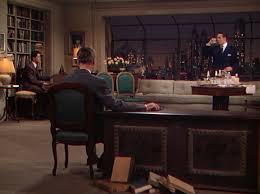
The original play by Patrick Hamilton most likely derives its central influence from the 1924 murder of 14-year-old Bobby Franks by Nathan Leopold and Richard Loeb. Students at the University of Chicago, the two young men committed the ‘crime of the century’ as a means of demonstrating their perceived intellectual superiority which they fervently believed was rationale enough for the despicable act. The circumstances as portrayed in Rope differ quite markedly from that of Leopold and Loeb, but the underlying motivation is essentially the same – the real-life murderers had a particular fascination with Friedrich Nietzsche’s concept of the superman. The victim Franks was also personally known to the two as he was Loeb’s second cousin. In the documentary Rope Unleashed, screenwriter Arthur Laurents alludes to the case of Leopold and Loeb as historical background, but of even greater interest are his comments on the homosexual subtext which permeates Rope. Back in the 1940s, the theme of homosexuality was a highly controversial one and Laurents speaks about how it was simply referred to as ‘it.’ The relationship between Brandon and Phillip is indeed a highly complex one with its references to their prep school days and time spent on Brandon’s mother’s farm (where Phillip used to strangle the chickens), and Laurents’s script is careful not to include any overt lines which might suggest their sexual inclinations. Brandon is constantly portrayed as the more confident of the two and Janet Walker even mentions them having had a relationship together in the past. It’s a testament to the subtlety of Laurents’s writing that the Production Code censors of the day did not raise a red flag in this regard. Nevertheless, the subtext is clearly there – the writer himself insists on its presence in Rope Unleashed. Finally, the theatrical trailer for Rope is quite unique insofar that David Kentley himself is given a speaking part in it; this surely must be one of the very few instances in which a character has more dialogue in a trailer than the actual film itself. We see him sitting on a park bench with Janet discussing their impending engagement which he wishes to hurry along. As he departs the scene, the familiar drawl of Jimmy Stewart comes up informing us, ‘That’s the last time she ever saw him alive. And that’s the last time you’ll ever see him alive.’ Hitchcock may not have watched Rope too often in his later years because he subsequently described it as an, ‘experiment that didn’t work out.’ It’s certainly far from his most seamless work coming from the decade just before he hit the very peak of his powers (with films such as Strangers on a Train, Rear Window, Vertigo and North by Northwest), but the film has an undeniable value and place in the director’s canon even if he did not appreciate this himself. For avid fans of Hitchcock, it’s an experiment that is more than worth checking out and is also of significance – as I previously noted – for marking the start of his collaboration with the great Jimmy Stewart. Recommended as more than just an interest piece.